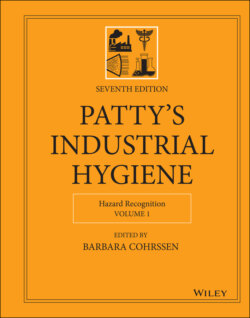Читать книгу Patty's Industrial Hygiene, Hazard Recognition - Группа авторов - Страница 90
9 PD CASE STUDY 9.1 Case Study: Large Winery Operation
ОглавлениеA large winery with an annual production capacity of over 1 million gallons of wine had concerns regarding the use of liquified sulfur dioxide (SO2). Management was alarmed when a minor release of pure liquified SO2 outside the facility sent an employee to the urgent care facility. Fortunately, the release was small and occurred outdoors reducing the severity of exposure.
Inhalation is the major route of exposure to sulfur dioxide. The odor threshold is five times lower than the OSHA permissible exposure limit (PEL) (5 ppm). Sulfur dioxide exposures can have both short‐term and chronic health consequences for people with lung disease. Inhaled sulfur dioxide readily reacts with the moisture of mucous membranes to form sulfurous acid (H2SO3), which is a severe irritant (13). The reaction of SO2 and moisture is presented below.
A second concern was discovered when a chemical dosing machine in the bottling line had a minor release during a change out of the chemical dimethyl dicarbonate (DMDC). The employees were evacuated without injury.
These two incidents led the winery to determine the level of risk and potential solutions. A risk assessment team was formed, and an assessment was performed. The team determined that the SO2 and DMDC exposure risks both presented multiple fatality – level risk and required immediate risk treatment.
Management sets the expectations, context, and objectives of the assessment. The risk assessment team was established that included the consultant as facilitator, the winemaker, assistant winemaker, cellar manager, operations manager, bottling department manager, maintenance manager, and Health and Safety Executive (HSE) manager.
Data were collected regarding the SO2 and DMDC operations, equipment and instruments used, instructions, chemicals, and their SDSs, operator training, procedures, and available incident information. A search for similar events involving SO2 and DMDC were also conducted. Employees were interviewed to learn from their experiences, concerns, and suggestions.
The two procedures were observed to document and understand the sequence of tasks and potential risks associated with tasks. Photographs, tank quantities, room dimensions and configurations, distances to exits, means of egress, and other physical attributes were collected.
After reviewing the information, the potential concerns of fatalities or serious incidents were discussed. Workplace exposures such as pure SO2 releases and DMDC releases which present a potential for fatalities or serious incidents must be given the highest priority and controlled to an acceptable level. As a side note, the consultant explained that unlike like less‐serious workplace incident rates, fatality, and serious incident/injury rates have not declined and do require serious attention. FSI exposures that can result in environmental releases, explosions, and disasters have been found to involve some of the following factors (14):
Unusual and nonroutine work
Nonproduction tasks
Facility modification or construction activities
Shutdowns and startups for repair and maintenance tasks
Exposure to high‐energy sources (e.g. electrical, steam, pneumatic, chemical)
Upsets (situations going from normal to abnormal).
Management agreed that the need to eliminate or reduce these FSI risk level exposure was required. With management input, the risk assessment team established risk criteria to be used for the assessment.
As determined in the initial investigation, concerns were identified by employees handling pure liquified sulfur dioxide in the dosing of wine tanks, and in the use of the DMDC dosing machine. A simplified PHA method was used to help identify hazards, analyze, and evaluate their risk levels, prioritize actions, and select controls using the hierarchy of controls model (Figure 8). The primary concerns were the use and storage of 100% liquified SO2 and DMDC.
